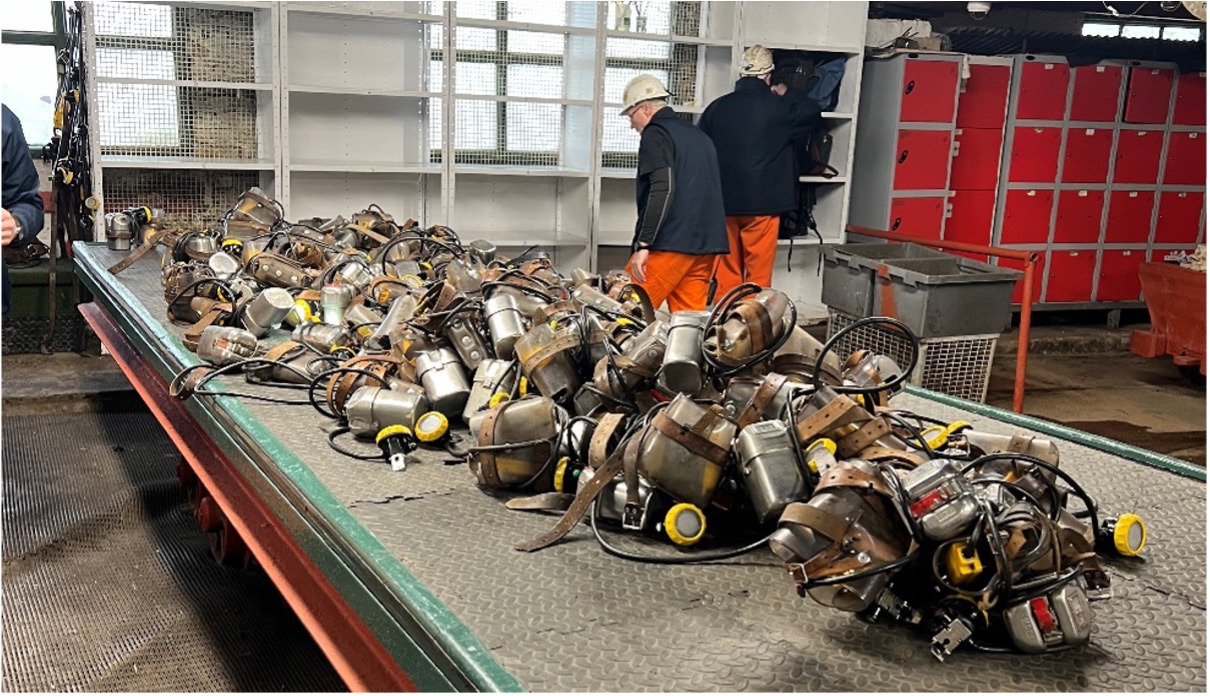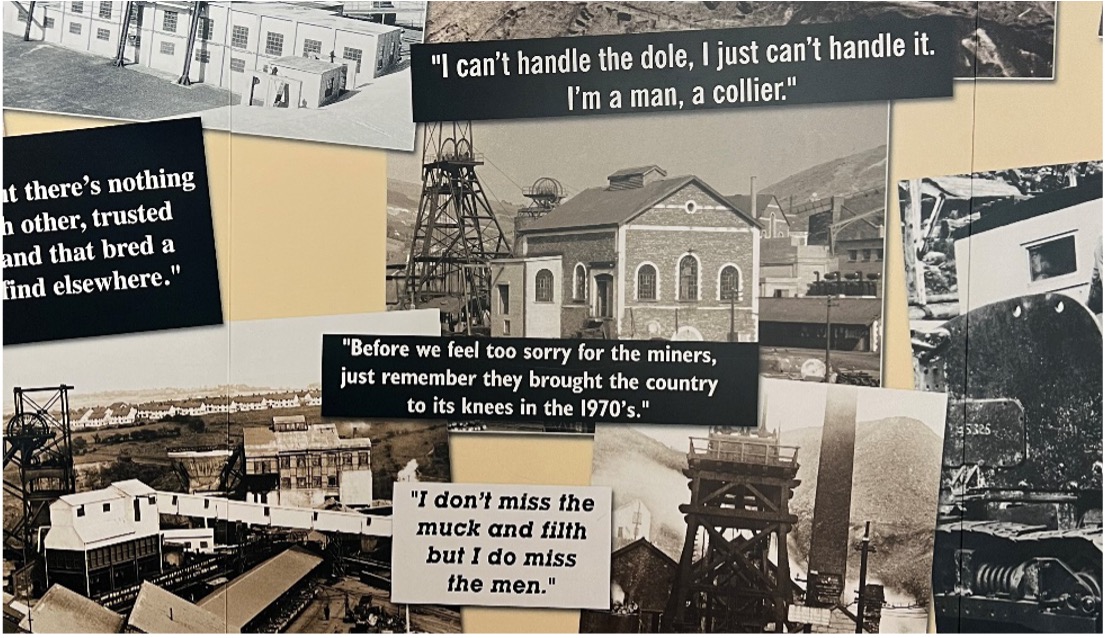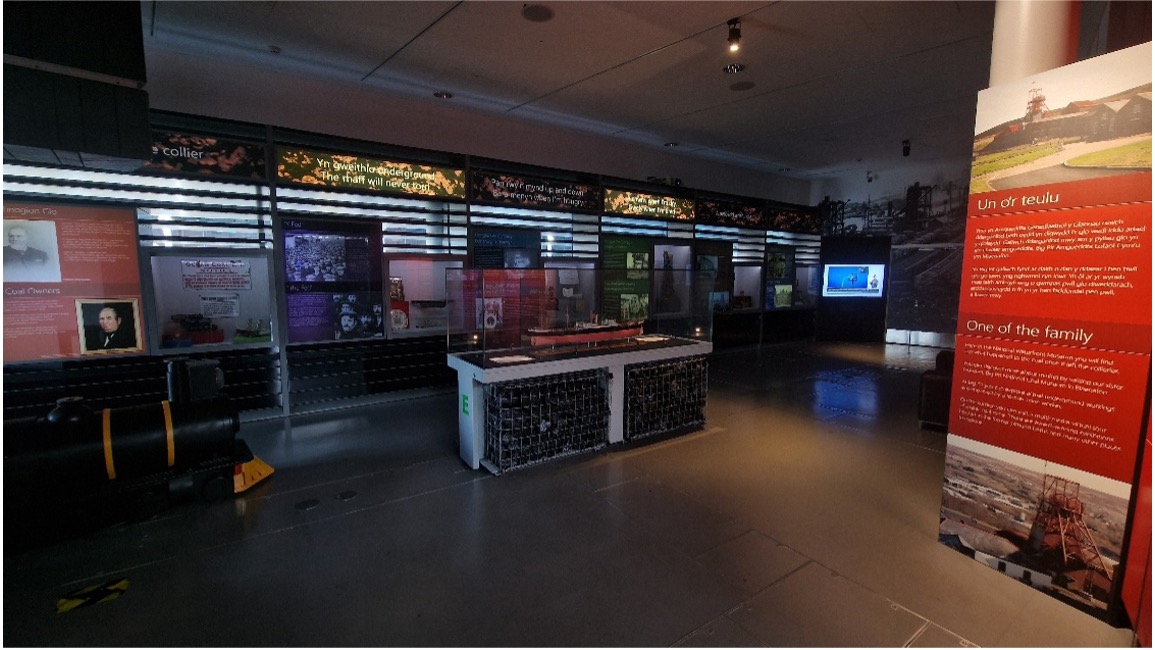Navigation auf uzh.ch
Navigation auf uzh.ch
Coal and steel are the two most important industrial resources in the history of Wales. The following article presents impressions from Big Pit National Coal Museums in Blaenavon, a small town in a South Wales valley, as well as the National Waterfront Museum in Swansea and their exhibits about these two Welsh resources.

Figure 1: Safety helmets, hat torches, and emergency masks for the tour at the Big Pit. Photo by Serafina Andrew.
Coal and steel – the two most important industrial resources in the history of Wales. The ‘black gold,’ as coal is often called, was the main resource extracted from the mines in the South of Wales up until the 1990s. It was considered the highest quality coal for many uses – including energy for military ships – as it produced little smoke. In addition to coal, iron ore was also extracted from the mines, and – together with ore from other countries and coke – was further processed in the country’s steel factories to produce the famous ‘British Steel’.
How is the history of the coal and steel industry portrayed and told in Welsh museums today – in the era of largely deindustrialised economies and a growing awareness of the devastating effects of burning the earth’s carbon deposits? After all, a museum is “a[n] […] institution in the service of society and of its development, open to the public, which acquires, conserves, researches, communicates and exhibits, for purposes of study, education and enjoyment, the tangible and intangible evidence of people and their environment. [1] In essence, museums are vital for preserving history and making it accessible to the public. They provide a space for reflection, learning, and inspiration, helping us understand the past to better navigate the present and future.
The Big Pit (National Coal Museum) in Blaenavon and the National Waterfront Museum in Swansea are part of the Amgueddfa Cymru (Museum Wales) charity – together with five more national museums across Wales. During our field trip to South Wales, I was able to visit these two museums (the former with the group, the latter on my own) and will therefore describe my experiences and impressions – I will do this in the first two sections, accompanied by pictures. In the concluding section, I will try to answer the question posed at the beginning of this article. I will also investigate the question of whether something is missing or whether – from my point of view – all the important key points have been told.
The Big Pit National Coal Museum was an active coal and iron mine until 1980. Just three years after its closure, it became a heritage museum and was opened to the public. The museum consists of various attractions for visitors: a winding house, sawmill, pithead, baths, and the pit bottom mine below ground. The highlight of the museum visit for me was the tour of the mine, which is ninety feet below the surface – not very far, compared to others in the area. At the beginning, you are equipped with a safety helmet, a head torch, and an emergency mask; for safety reasons, you are not allowed to carry any electronic devices with you. You then enter the mine lift (the “cage”), which takes you down to the mine level. During the tour, the tour guide explains the technical progress made in the mine over the years. This includes, for example, the safety of the workers or the transport of the extracted goods to the surface. In addition to these aspects, social and community issues are also addressed: the gap between the poverty of the workers and the wealth of the mine owner, the division of labour in connection with child labour, controversies over women’s labour in the 19th century, and the bond between the workers.
As mentioned, the museum consists not only of the mine underground, but also of numerous buildings on the surface. One of them now shows the development of mining techniques in modern times – the visitors are guided through this exhibit by video screens. There, a miner, played by an actor with a strong Welsh accent, reappears to explain technology, its use and labour conditions in colloquial language. In another building, the bathing rooms are particularly worth mentioning. They consist of the original facilities that were used by the mine workers up until 1980. They are complemented by an exhibition that makes use of the lockers and other elements of the original set-up. In contrast to the mine, which is mostly empty, the exhibition showcases hundreds of artifacts from the past. There is also a greater focus on historical events, changes, and conflicts, which are described and narrated with the help of texts, as well as writings and videos. Labour struggles play a large role here. The exhibition therefore complements and extends the mine tour but can also be understood and visited without taking part in the underground tour. I found the locker rooms particularly exciting: On individual lockers, visitors can find pictures of their former users and a brief description of their life after working in the mines. The museum also tries to connect the history of the shaft with the question “Was it worth it?”. The coal industry had a lot of impact on various fields of interest: On the one hand there are negative points such as climate change, and the pollution and environmental damage. On the other hand, the industry also helped to form communities, provided healthcare and international connections. Overall, the Big Pit National Coal Museum provides a full-body experience which makes the visit enjoyable and different from other museums due to its immerging approach to the topic and the connection to the present.

The Waterfront Museum in Swansea was opened in 2005 as a part of the “revitalisation” of the Swansea Marina area. Its exhibitions show the Welsh history of the industrial and maritime revolution and evolution. It is located in an old warehouse right by the sea. The museum uses a variety of media tools to convey information: Tablets that enable visitors to ask questions themselves, videos which are subtitled with sign language, or documentary audio recordings to which you can listen. The museum’s exhibitions are divided into themed areas, all of which are organised under the headline of Welsh history and culture: The rooms on the upper floor, for example, deal with everyday crafts or the sense of community in Wales. On the lower floor, the industrial revolution, natural resources and especially the coal and steel industry in Wales are presented. Each themed area is labelled with a symbol so that visitors can identify easily where the focus of this part of the exhibition lies.

The coal and steel exhibition includes a small room that deals with the historical background of mining. Topics such as child labour, the poor working conditions, and the closing of the mines are touched on in short texts, but not dealt with in depth. There are pictures and a few objects from the mines, such as lamps or pickaxes. At the entrance to this room, there is a reference to Big Pit, with the information that the topics are presented there in greater depth and in more detail. Steel shares an area with displays about the resources iron ore and copper. The history of steel is told in a few texts, with the harbour towns of Cardiff and Port Talbot featuring prominently. Major producers such as Tata Steel are mentioned. Overall, the Waterfront Museum provides a large amount of overall information on Welsh history in which the coal and steel industry is one part. It is therefore presented on a rather small scale.
The focus of this article was to show how museums exhibit the history of the Welsh coal and steel industry, based on visits to the Big Pit Coal Museum and the Waterfront Museum. Both show the history of the two resources coal and steel, but the specialisation is clearly different. In the most basic sense, the Waterfront Museum focusses on general Welsh history and therefore cannot and does not want to go into great detail regarding coal and steel. Instead, it provides a general overview. Although the aim is to educate, visitors should not be overwhelmed with information, which they would not be able to memorise, and it can also become boring if a museum is only full of texts. The various digital media that are used are an effective way of engaging visitors in the exhibition.
In Big Pit Coal Museum, the focus is clearly on coal mining and especially the people behind the work. This makes sense as you are dealing with a former mine. Not only is the coal industry dealt with in much greater detail, the tour through the mine itself presents history in a material and immersive way, as visitors can experience some aspects (however limited) of working underground for themselves. Importantly, the museum can also be seen as a memorial site where former miners and their relatives return to remember the past – the country’s and their own. Price and Rhodes (2020) state: “Heritage sites and landscapes serve as a manifestation of communal memory”. [2] The Big Pit can be seen as such a heritage site due to its original structures and also the connection to present topics such as the climate change.
So, to answer the question posed at the beginning: the history of the coal and steel industries is presented in both museums in activating and diverse ways. The aim is to inform visitors about diverse topics and provide a rough overview. As mentioned above, the Waterfront Museum provides information on various themes and therefore they cannot go into much detail on every single one. They rather seem to want to let the objects speak for themselves than overwhelm the audience with large amounts of descriptions. In both museums, the focus is not only on ‘good’ events of which everyone should be proud, but also on more difficult topics such as child labour and exploitation, as these must not be forgotten in the history of the mines. In some cases, I would have liked to have gone into more detail on individual aspects and contemporary events, such as the disputes surrounding Tata Steel and Port Talbot, but I realise that it is difficult for a museum to pick up on such matters exhibit them in a short space of time. It is also not the primary mission of historical museums to deal with the present. In the case of the Waterfront Museum, however, there is an exhibition area that takes up and reflects current themes. I started wondering whether they could exhibit today’s problems and discussions around Port Talbot and Tata Steel. In addition, the more topical an exhibition is, the easier it is to find witnesses who can talk about their individual experiences. This can also be interesting for visitors. Also, the museums are obviously limited by the space they have to construct their exhibitions. They must make decisions about what they want and can exhibit with the given circumstances.
Furthermore, one always has to keep in mind that museums are also attractions built to entertain a popular audience. The mine tour at the Big Pit for example seemed to be structured like a play; all the information told by the guide seemed like a script learned by heart. Of course, the information given to us was important, but a major focus was on entertaining the group. The museums have to think economically, as it were, to remain interesting and attract people. To manage this, they need to find a balance between giving information, providing food for thought, and being entertaining.[3]
[1] International Council of Museums. 2022. Museum Definition. accessed 01.07.2024. https://icom.museum/en/resources/standards-guidelines/museum-definition/
[2] [3] Price, William R., and Mark Alan Rhodes. 2020. “Coal Dust in the Wind: Interpreting the Industrial Past of South Wales.” Tourism Geographies 24 (4–5): 837–58. doi:10.1080/14616688.2020.1801825.
Melissa Fricke